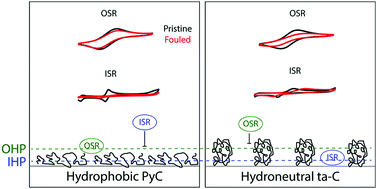Biofouling affects the redox kinetics of outer and inner sphere probes on carbon surfaces drastically differently – implications to biosensing†
Abstract
Biofouling imposes a significant threat for sensing probes used in vivo. Antifouling strategies commonly utilize a protective layer on top of the electrode but this may compromise performance of the electrode. Here, we investigated the effect of surface topography and chemistry on fouling without additional protective layers. We have utilized two different carbon materials; tetrahedral amorphous carbon (ta-C) and SU-8 based pyrolytic carbon (PyC) in their typical smooth thin film structure as well as with a nanopillar topography templated from black silicon. The near edge X-ray absorption fine structure (NEXAFS) spectrum revealed striking differences in chemical functionalities of the surfaces. PyC contained equal amounts of ketone, hydroxyl and ether/epoxide groups, while ta-C contained significant amounts of carbonyl groups. Overall, oxygen functionalities were significantly increased on nanograss surfaces compared to the flat counterparts. Neither bovine serum albumin (BSA) or fetal bovine serum (FBS) fouling caused major effects on electron transfer kinetics of outer sphere redox (OSR) probe Ru(NH3)63+ on any of the materials. In contrast, negatively charged OSR probe IrCl62− kinetics were clearly affected by fouling, possibly due to the electrostatic repulsion between redox species and the anionically-charged proteins adsorbed on the electrode and/or stronger interaction of the proteins and positively charged surface. The OSR probe kinetics were less affected by fouling on PyC, probably due to conformational changes of proteins on the surface. Dopamine (DA) was tested as an inner sphere redox (ISR) probe and as expected, the kinetics were heavily dependent on the material; PyC had very fast electron transfer kinetics, while ta-C had sluggish kinetics. DA electron transfer kinetics were heavily affected on all surfaces by fouling (ΔEp increase 30–451%). The effect was stronger on PyC, possibly due to the more strongly adhered protein layer limiting the access of the probe to the inner sphere.

- This article is part of the themed collection: 2020 PCCP HOT Articles


 Please wait while we load your content...
Please wait while we load your content...